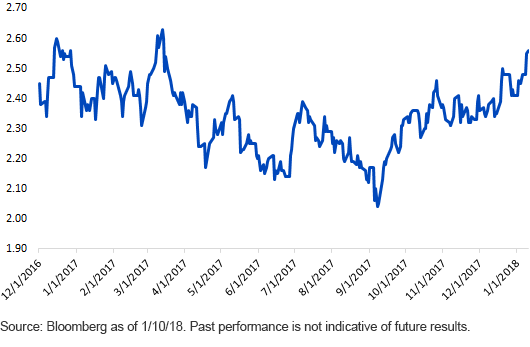U.S. Treasuries: Starting Off on the Wrong Foot


There is no doubt 2018 has gotten off to a far different start for the U.S. Treasury (UST) market as compared to the last few years. Indeed, from 2014 through 2017, the UST 10-Year note rallied in the first month or so in each year, but thus far in 2018, just the opposite has occurred. Remember, what happens in January does not necessarily dictate the trend for the remaining 11 months of the year, but given the movement of the last week or so in 10-Year Treasury yields, some perspective is needed.
Interestingly, the rise in government bond yields has not been isolated to the U.S., as essentially all of the G7 nations have seen increases. As of this writing, 10-year government yields have risen, on average, by roughly 15 to 30 basis points (bps) from their mid-December low-water marks. For the record, the UST 10-Year increase is pegged at about 20 bps and was quickly approaching the 2.60% level at one point, the highest reading since March.
U.S. 10-Year Treasury Yield

The early 2018 uptick in the UST 10-Year yield had really nothing to do with the fundamentals, namely economic data or a shift in the Federal Reserve (Fed) policy outlook. Rather, the catalyst was coming from offshore. One of the key influences to watch for in the 2018 U.S. rate outlook will be other central bank policy actions, specifically from the European Central Bank (ECB) and the Bank of Japan (BOJ). This is precisely what caught investors off guard to begin the new year.
First up, in Japan, the BOJ surprisingly announced it was dialing back on its longer-dated securities buyback program, and that was followed by reports ECB officials have been contemplating the notion of tweaking their policy guidance, with an eye on their quantitative easing program. As a reminder, the current ECB QE program was adjusted in October, when the amount of purchases was reduced to €30 billion and extended through September of this year. Obviously, the actual policy outcomes are of vital importance, but one could make the case that “how we get there?” is equally important. How the ECB and others communicate their intentions is very important to the bond market. The Fed has given investors an example of success (last year’s balance sheet normalization plan) and an example of failure (the taper tantrum).
Now, let’s throw China into the mix. At around the same time the aforementioned news was coming out, reports that China was considering either slowing or halting its purchases of Treasuries was “hitting the tape.” How serious should investors take such headlines? China has been cutting back its purchases of Treasuries for a while now. To provide some perspective, through October (latest data available), China’s holdings were pegged at 18.7% of the foreign total amount versus a peak of 28% in 2011. For the record, the percentage got down to as low as 17.6% in November 2016 (for those interested, the next report comes out later today). In addition, following the UST 10-Year sell-off in response to this headline, China’s State Administration of Foreign Exchange (SAFE) put out a statement saying this news report “might have cited wrong sources or may be fake news.”
Conclusion
Now that you’ve digested all that, what’s the bottom line here? Investors will need to watch foreign central bank developments closely. While any potential further news regarding China’s purchases will no doubt bear scrutiny, how the ECB prepares the markets for its September end date and how the BOJ communicates any modifications to its buying program will probably move to center stage.
Want some good news? If you follow technical analysis, the backup in the UST 10-Year yield placed it right back up to the “oversold” line when looking at the relative strength index chart. Over the last year or so, each time that has happened, the 10-Year then rallied. Interestingly, last week’s UST 10-Year note auction was met with stellar demand, no doubt a result of the yield increase. On that front, perhaps, some things never change. Stay tuned.
Unless otherwise noted, data source is Bloomberg as of January 10, 2018.
Important Risks Related to this Article
Fixed income investments are subject to interest rate risk; their value will normally decline as interest rates rise. In addition, when interest rates fall, income may decline. Fixed income investments are also subject to credit risk, the risk that the issuer of a bond will fail to pay interest and principal in a timely manner or that negative perceptions of the issuer’s ability to make such payments will cause the price of that bond to decline.

